False Facts About Sweet Potatoes You Thought Were True
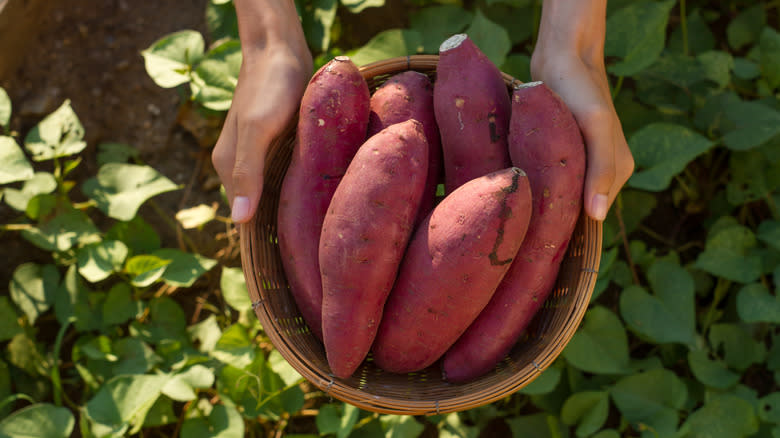
The sweet potato might not seem like a particularly mysterious subject, but you'd be surprised by how much misinformation there is out there. In fact, there are many false facts about sweet potatoes that you probably think are true. That's why we're here to bust some myths and get to the bottom of things.
For starters, many people believe that sweet potatoes and yams are the same thing — but nope! And, if you think that a sweet potato is related to a white potato, think again. Then, there's the misconception that they're all starch and sugar and not especially nutritious. Keep reading to have us shed some light on all these false facts and more.
Whether you're hoping to learn more about sweet potatoes or you're just curious about what you might have got wrong, you're in the right place. There's more to these root veggies than meets the eye, so let's set the record straight.
Read more: 15 Mistakes Everyone Makes When Cooking Eggs
False: Sweet Potatoes Are Closely Related To Potatoes
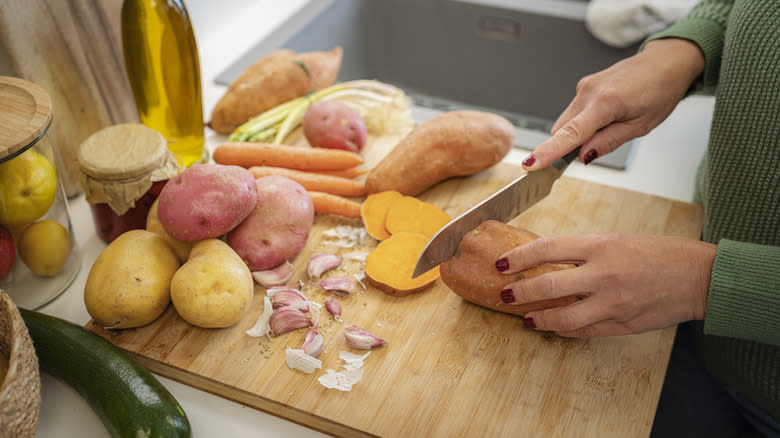
It's a common belief that sweet potatoes are closely related to potatoes. After all, there's literally the word potato in the name. It just makes sense. But, in actual fact, they're two entirely different plants. Both are root vegetables or tubers, but they're only very distantly related. It's not like a sweet potato is just a sweeter variety of a regular white potato. We can see where it gets confusing, but once you know more about each, it makes more sense.
The botanical name for the sweet potato is Ipomoea batatas. And, while you might think of it as a vegetable, it's really the tuberous root of a type of vine belonging to the morning glory family. Others in this family include morning glory flowers, moonflowers, and bindweed. By contrast, potatoes — or Solanum tuberosum — belong to the nightshade family. Other members of this botanical family include peppers, tomatoes, aubergines, and — yes — even deadly nightshade. So, your average potato is more closely related to a bottle of ketchup than it is to a sweet potato.
False: Sweet Potatoes And Yams Are The Same Thing
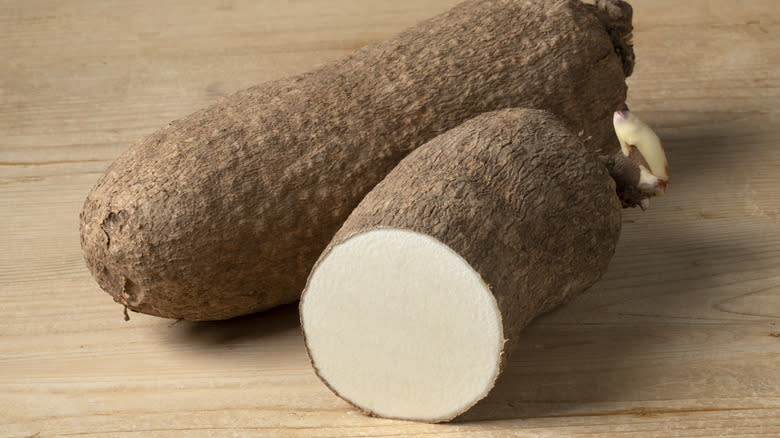
"Okay, okay, so sweet potatoes aren't true potatoes. But, they are yams, right?" We hate to tell you, but that's wrong. Yams and sweet potatoes are two completely unrelated plants. But, we understand your confusion. Sweet potatoes are often referred to as yams colloquially in the U.S. — and sometimes they're even labeled as yams in the grocery store.
So, what's the difference between sweet potatoes and yams? Well, yams are native to Africa and Asia. They belong to their own botanical family, Dioscoreaceae. Unlike sweet potatoes, which have thin, edible skin, these tubers have thick skin that's often brown and looks a lot like tree bark. While the flesh inside a yam can be orange (among other colors), it isn't sweet. Rather, it has a neutral flavor that's more similar to yucca or white potato than to the vegetable that tries to steal its name.
So, why the confusion between the names? It seems to date back to the time when enslaved people were forcibly taken to America. These people referred to the sweet potatoes they encountered in the U.S. as yams because of certain similarities between them and the yams they were used to back at home.
False: Sweet Potatoes Are Always Orange
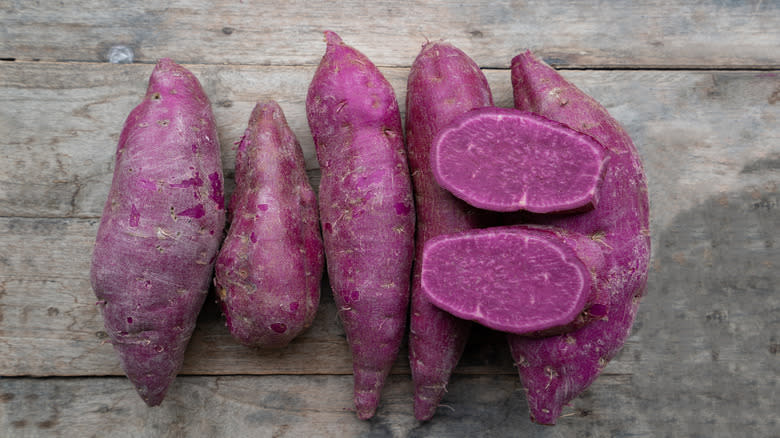
Think of a sweet potato. You're picturing something orange, aren't you? That's understandable, orange sweet potatoes are the most common type in the U.S., but if you think that all of these tasty roots are orange, we're about to blow your mind. Sweet potatoes also come in purple and white varieties. Sometimes they look the same as orange sweet potatoes from the outside, but when you cut inside, the flesh is different. But, with other varieties, you can tell from the exterior that this isn't your run-of-the-mill sweet potato.
And, it's not just the color that's different. They vary slightly from the orange type in other ways. White sweet potatoes are slightly drier than the orange type. This makes them good for dishes such as gnocchi where too much liquid can lead to trouble. They also tend to hold their shape better in the oven and don't go mushy so easily.
Purple sweet potatoes are a little starchier and drier than their orange siblings. They can take longer to cook, so if you switch orange for purple in a recipe, you might need to adjust. Purple varieties also contain antioxidants called anthocyanins, which may have a positive impact on brain health and reduce the risk of dementia.
False: Sweet Potatoes Are All Starch And Aren't Nutritious
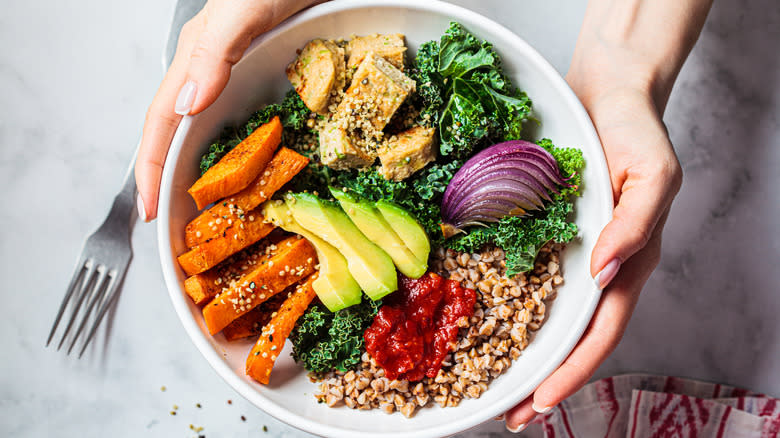
Sweet potatoes are starchy vegetables, and these can get a bad rap. So, you might have heard that sweet potatoes are basically all starch and sugar and aren't especially nutritious. This is false, and sweet potatoes are highly nutritious and have a range of potential health benefits.
First off, let's look at their nutritional content. One cup or 7 ounces of sweet potato contains 213% of the recommended daily intake of vitamin A, 44% of your recommended intake of vitamin C, and 34% of the vitamin B6 you need each day. Then, there are minerals. The same quantity contains 43% of your daily intake of manganese, 36% of the copper you need each day, and 20% of your daily value of potassium.
But, how are they good for your health in real terms? Sweet potatoes are good for the gut due to the fact they're rich in fiber, containing 6.6 grams per cup. The antioxidants found in them also benefit digestive health, as they feed the good bacteria in the gut.
Orange sweet potatoes are rich in beta carotene, an antioxidant that's important for eye health. The same compound also supports the immune system, which is vital for general health and well-being. People with lowered immune systems are more likely to catch viruses when they go around.
False: You Should Store Sweet Potatoes In The Fridge
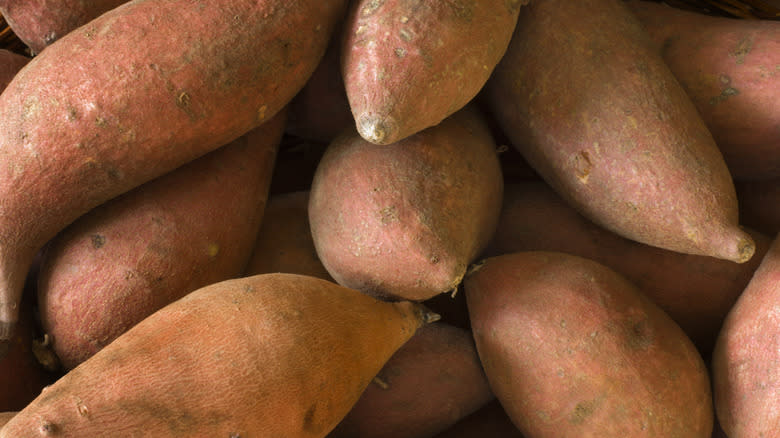
Many vegetables are best stored in the fridge, but not sweet potatoes. This might come as a surprise as you may assume that keeping them in the fridge would make them last longer. But, it's not about shelf life — the reason you shouldn't store sweet potatoes in the fridge is that it affects their texture and flavor. Although keeping them in the fridge might make them last longer, they can develop a bitter flavor when stored this way. Sweet spuds stored in a refrigerator may also turn hard in the center and take longer to cook due to a change in the cell walls caused by this storage method.
Instead, you should store them somewhere dark and cool (but not cold). A store cupboard or pantry is the ideal spot. Dampness can cause them to rot, so keep them out of high-humidity areas, such as cabinets next to the stove. To prevent moisture from building up, keep them in a breathable container, such as a paper bag. If they came in plastic, remove them from this before storing.
Of course, the no-refrigerator rule only applies to whole raw sweet potatoes. Once cooked, any leftovers should be stored in the fridge and eaten within around 3 to 5 days. Chopped raw sweet potatoes are also best kept in the fridge, but preferably don't chop more than you need.
False: Sweet Potatoes Are Only Good For Dessert
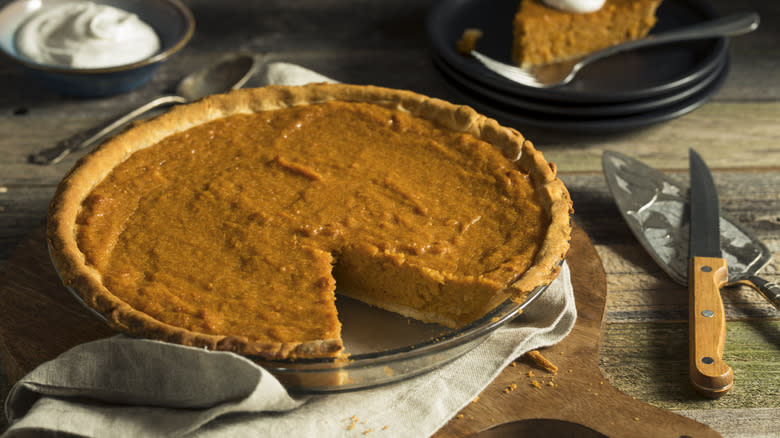
Sweet potato pie is such a classic recipe, that some people believe sweet potatoes are only good for dessert. Plus, they're used in other sweet recipes, such as loaf cakes and as a secret ingredient in chocolate cakes. The word "sweet" in the name only further perpetuates this myth. However, they're more versatile than some people realize. Yes, these potatoes are sweet, but they can also be used in savory recipes.
There are so many ways to use sweet potatoes in savory meals. You can use them in soups, stews, and casseroles. They're delicious roasted in chunks and used in salads or grain bowls with a tasty dressing that complements their sweetness. You can cook them up instead of potatoes in a range of recipes, including gnocchi or gratin. They taste great in various pasta dishes, tacos and burritos, and a range of sheet pan meals.
We love how easily they transition from sweet to savory. But, of course, they do have a lot of natural sweetness to them. You can balance this by using an appropriate amount of salt (just don't overdo it), pairing them with spices, or using herbs like sage or thyme that have a deeply savory flavor profile. Also, using plenty of aromatics — including garlic, ginger, onion, and celery — helps to give you a balanced dish that isn't overly sweet.
False: There Are Limited Ways To Cook Sweet Potatoes
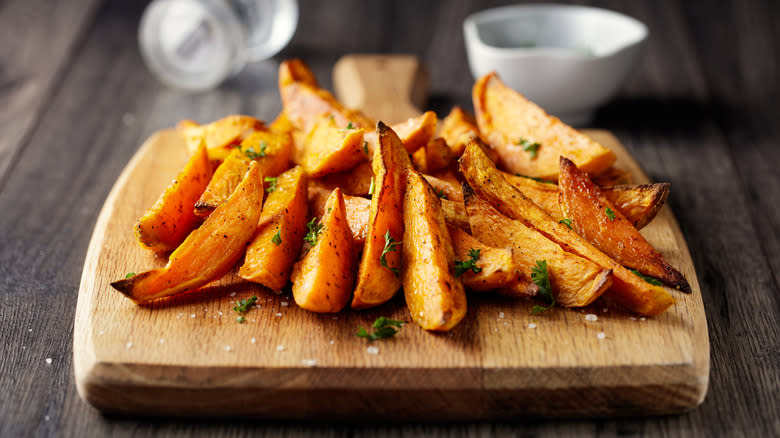
Many people think there are limited ways to cook sweet potatoes. It's common for folks to learn one cooking method and assume it's the only way. So, whether that's roasting, steaming, baking, or frying, you might assume that it's your way or the highway. But there are several great options for cooking these popular starchy veggies.
So, what are some of the most common sweet potato cooking methods? Many people like to bake them and eat them split with toppings or fillings. You can also slice into them before baking and cook them Hasselback style. Another popular method is to chop them into chunks or into french fry shaped batons and roast them in the oven until soft on the inside and slightly crispy on the outside. They can also be boiled and mashed, or boiled or steamed and eaten in chunks as a side.
And, if you want to go beyond basic cooking methods, you can find a huge number of sweet potato recipes to try. There are sweet recipes, like sweet potato pie and cakes or muffins containing sweet potatoes. As well as plenty of savory recipes, including fritters and quesadillas.
False: You Should Wash Sweet Potatoes Before Storing Them
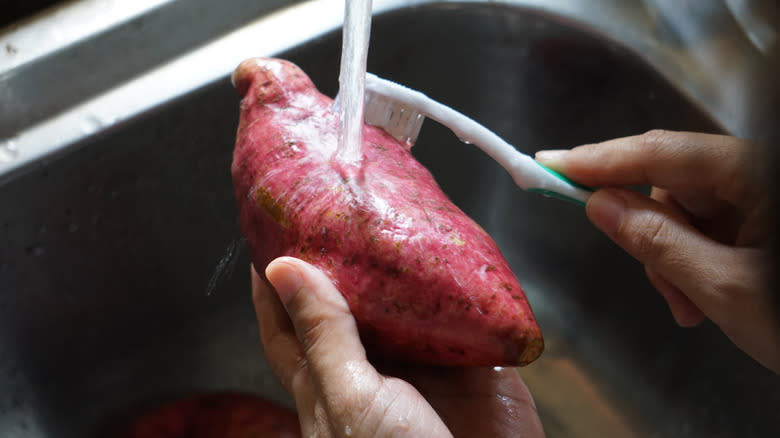
If you get your sweet potatoes covered in earth from the farmer's market, you might assume that you should wash them before you store them. After all, this seems like the logical solution. It avoids the risk of getting dirt in your pantry and saves you some time down the line when you come to cook them. However, the correct thing to do is to leave them dirty until you come to cook with them.
Generally, they're kept dirty during storage and only washed as a last step before being packed and shipped to stores. However, when you buy direct from the producer or from a small supplier, you might get them with the dirt intact — and that's a good thing. Sweet potatoes are prone to bruising, and the dirt helps to protect them. So, if you want them to stay in good nick for longer, the earth should stay.
The other factor is that moisture causes sweet potatoes to spoil faster. So, if you wash them before storing them, there's a chance they won't be fully dry before you put them away. And this can lead to sweet potatoes that rot and go mushy before their time.
False: Sweet Potatoes Only Grow In Warm Climates
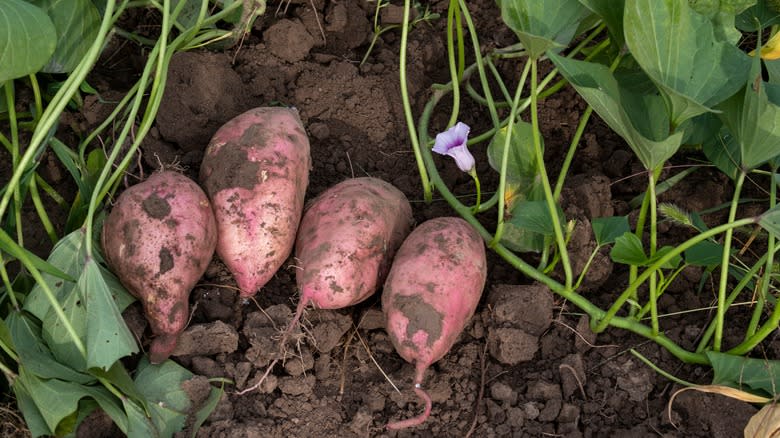
You might think of sweet potatoes as vegetables that only grow in warm climates. Now, it's true that this plant is native to tropical regions of Central and South America. And, it's also a fact that sweet potato plants love warmth and are sensitive to cold. However, you can grow them in colder climates if you choose to.
You have to make some adjustments when you want to grow these tasty roots somewhere cool. First, you need to choose the spot you grow them in carefully. Ideally, it should get full sun to make the most of the heat and daylight that you do get. The location you choose to grow in should also be sheltered, to block cold winds. If you have a greenhouse, even better.
Mulching your plants provides some extra heat, but you should make sure that you prepare your soil so that it's sandy and drains well. This is especially important if you live somewhere cool and wet, as waterlogged soil could cause your sweet potatoes to rot. Covering young plants to protect them from the wind and the cold will also improve their chance of thriving.
False: Sweet Potatoes Have Always Been Popular
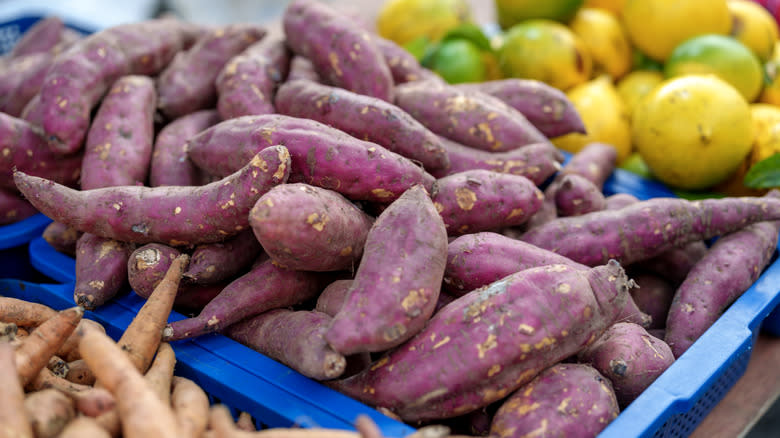
Sweet potatoes have always been popular, right? Sorry to break it to you, but if you think that sweet potatoes have always been equally popular or have steadily gained popularity over the years, there's a dip you might not be accounting for.
During World War II, the United States grew a lot of sweet potatoes. Keeping people fed while still having the people and resources that the military needed was an important part of the war effort. Sweet potatoes were extremely easy to grow, so they became a staple crop. By the end of WWII, the U.S. was producing 3 billion pounds of sweet potatoes a year.
When the war ended, food scarcity wasn't an issue any more, and sweet potatoes started to fall out of fashion. Initially, perhaps, because people were so sick of eating them during the war years. Eventually, production bottomed out at 1 billion pounds in 1980. But, the tables began to turn. As folks in the U.S. started to see sweet potatoes as tasty and nutritious, production numbers gradually started to rise again. By the time 2015 came around, the U.S. was producing more sweet potatoes than any time since the war — 3.1 billion pounds annually.
Since then, production peaked in 2017 and has slightly declined since then. So, it's possible that we're about to witness another sustained dip in popularity. Or, perhaps it's just a blip. Only time will tell.
False: Sweet Potatoes Are The Same In Every Country
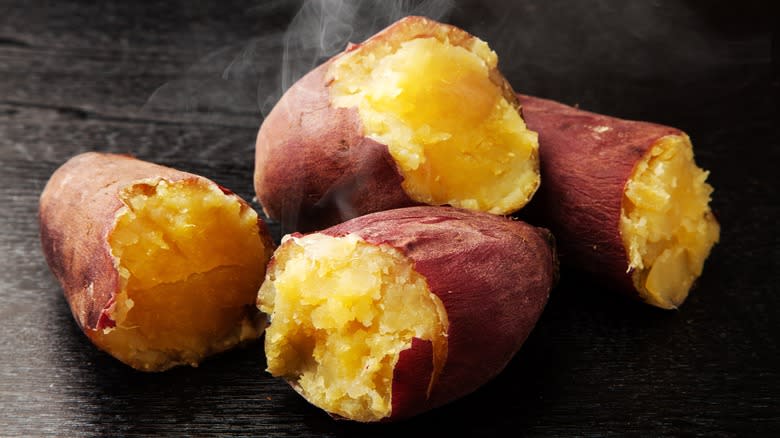
It makes sense to assume that sweet potatoes are sweet potatoes — they're the same in every country. But, maybe you haven't met the Japanese variety. They have subtle but notable differences from the types you're used to in North America.
So, how are Japanese sweet potatoes different? First of all, let's talk about appearance. Their reddish purple skin looks similar to that of the American variety at first glance. However, the flesh inside is somewhere between white and pale yellow. But, they don't just look different, the flavor and texture is slightly different, too. They aren't as sweet as the versions you're used to in the U.S. Rather, they have a more subtle sweetness. This makes them great for use in recipes where too much sweetness can detract from the finished dish. As for the texture, these potatoes aren't as moist as American types, which gives them a fluffier texture when cooked. Some say they're more texturally similar to russet potatoes.
The drier texture means they have less of a tendency to go soggy than their American siblings. So, if you often struggle to get your sweet potato fries crispy or you've had issues with overly wet sweet potato mash, you might want to see what Japanese variations have to offer.
False: Only The Root Of The Sweet Potato Plant Is Edible
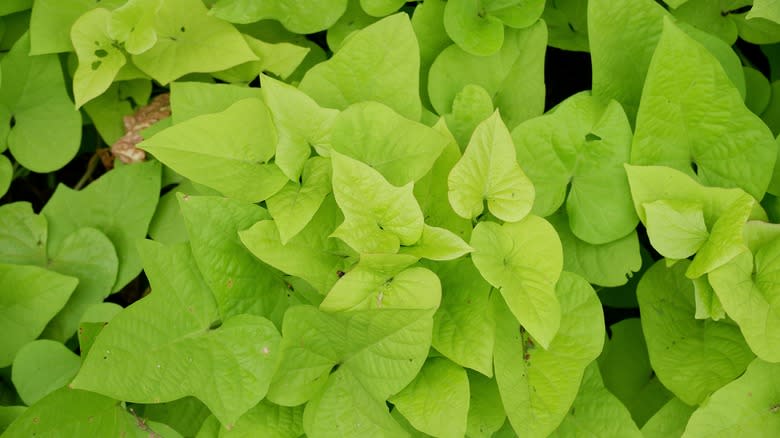
The part of the sweet potato plant that we generally eat is the tuberous root. Because this is really all we experience of the plant in Western cuisine, it makes sense to assume that the rest of it is inedible. Wouldn't we be eating the other parts if it was possible? Well, it seems not, because the leaves and vines are indeed edible.
In parts of Asia, sweet potato greens are in regular rotation. For instance, in a common Korean side dish, Goguma Chilge Muchim. So, if you want to experiment with either the leaves or the vines, there are plenty of tried and true recipes out there. However, you can also simply sauté them like you would chard, kale, or spinach, if you don't want to go to the trouble of following a recipe.
In fact, it's not cooking sweet potato greens that's the hard part — it's finding them. Despite the popularity of sweet potato roots, the greens are rarely found for sale. You may occasionally find them at a farmers market, but otherwise, you'll need to grow them yourself to experience them.
Read the original article on Mashed


